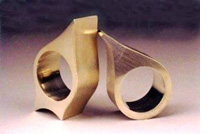In the Beginning…
I’ve never truly known what it is I wanted to be. I had the typical desires that children have, though mine were mostly influenced by movies. I saw Space Camp and wanted to be an astronaut, until I found out how much math would be involved. I watched Top Gun until I had nearly every line memorized, hung posters of F-14 tomcats up in my room, and even half-heartedly began ground school in an effort to be a fighter pilot. Then I found out fighter pilots need 20/20 vision, so the posters came down.
What Do I Want to be When I Grow Up?
Many members of my family were accomplished artists. I made jewelry as a hobby while in high school but thought that I could never pursue it because I thought I needed to be really good at drawing. I ended high school as a young woman who wanted to be an actress, and when I entered college, it was as an English major. I briefly majored in education, but making art continued to nag at me. I took classes to learn how to draw and slowly became an accomplished metalsmith. Finally I settled on getting my BFA in Studio Art with an emphasis in Metalsmithing. As a senior in college, I applied to Graduate School and was accepted at The Rhode Island School of Design in the Jewelry and Light Metals Program, one of the best in the country.
All the while, I was unsure of what I really wanted in life. I knew that I loved making art, but that I couldn’t see myself making it for a living. I thought I wanted to teach jewelry-making at an art school, but the job openings were few and far between. Like many people, I settled for just getting a job once I graduated. My hope being that I would eventually find a career that pleased me. I had always assumed that the job of my dreams was out there, and that it would find its way to me.
But is It Art?
The job I settled for was at a retail home goods store. I am a very organized and personable person and I quickly moved up the ranks. I tried to find a way to use my design skills, but kept getting flattered into management roles. I loved the training part of the job, and I really loved the people I worked with. I was making interesting and fun friends but I found being a manager unfulfilling and frustrating. I always felt that no matter how long or how hard I worked it felt like I hadn’t done anything. I needed to be making something. I needed to be able to see or touch the results of my efforts, not just end up with well-done paperwork and praise from the higher-ups.
As my frustration with work progressed, I finally got to a point where I couldn’t do my job and find time and energy to explore new jobs and careers, and there seemed to be little time for making art, either. I was able to stay with the same company, but take a step down to do more design work. It was better than management but I was still lacking something. I began to feel that itch for a new job, but really wanted guidance. I wanted someone to tell me what it was that I was suited to do.
Is It Too Early for a Mid-Life Crisis?
My 30th birthday was a clichéd wake up call. I woke up with a feeling of dread, what was I doing with my life? I had spent 6 years perfecting my craft and now I was stacking wine glasses precariously on top of one another. So on my 30th birthday I began wondering what else was out there for me. The process was slow going. I would look at job descriptions that seemed exciting but also completely unattainable and fall deeper into job depression. I started writing a blog in the hopes that it would help me vent my frustrations. A year passed and I still had not actively pursued looking for a job. In the meantime I was promoted again, and felt so disenchanted with the job that I didn’t even allow myself to celebrate the achievement. I realized that while the job was more creatively stimulating than being a manager, it was by no means my dream job.
Finally, I gave myself an ultimatum. Find a new job by September, or quit outright and be unemployed. I found myself wishing desperately for a guidance counselor. I seriously considered going to a local high school to see if someone would tell me what I was meant to do. I’ve often been told that I look young, but who was I kidding, I wasn’t going to pass for high school, unless I was on a TV show. Instead I spoke to a friend who told me about the Johnson O’Connor Research Foundation. I was immediately interested in the concept of having someone objectively measure my skills, in having a stranger tell me, “Yes, you’re good at these things, and this is what it means in terms of job activities.”
Taking Some Tests
On the day of my testing, I approached the whole experience with a pretty intense fervor. I wanted this to answer all my questions and to unequivocally tell me what I was destined to do. I wanted to be shocked by the results. Instead, and I’ve come to see how this is just as valuable, the results of my testing gave me a newfound confidence. Surprisingly, the results showed that the job I was currently in wasn’t a horrible fit.
The testing itself was fascinating; not written tests, like school—I was actively doing things. Some of the tests were a lot of fun, like Paperfolding and Wiggly Block, and others I thought were no fun at all, like the auditory tests. I guess that’s a good way to look at aptitudes: things that are easy are fun (aptitudes) and things that are really hard are no fun (areas in which we lack aptitudes). The results of my testing fit with this theory, as I am a spatial thinker, and not musical at all.
When I Liked My Job…
As a store designer, I was able to actively control the merchandising plan of the store, which did involve some visualizing in three dimensions. This activity also drew upon my ability to generate lots of ideas, an aptitude called Ideaphoria. I was free to decide which sofa to put with which rug and how the room itself was set up.
Sometimes I would plan a specific room only to discover the product had been scratched. Then it was completely up to me to figure out a solution. I loved the problem solving aspects of fitting a set number of things into an unforgiving floor plan. At these times, I was using an aptitude called Inductive Reasoning. People who score high do well in situations that offer daily challenges, new things to figure out as often as possible. Often I was forced to come up with a unique solution to the problem of how to display things, this often involved me “creating” some kind of rigging or tool. This was definitely when my job was most fulfilling for me, when I was actually making something and solving a problem in a design way. I learned that my satisfaction stemmed from using my main aptitudes: Ideaphoria, Structural Visualization, and Inductive Reasoning.
When I Didn’t Like My Job…
The issue was those times were few and far between. And while it was challenging at first, often the day-to-day monotony was taxing. Plus, I felt that I had stopped working towards a goal; I had become the designer of a store and that was the point of this career track unless I wanted to go back to managing again. I have many of the aptitudes a good manager needs to have, but it was never enough for me to merely talk about ideas and then not get to do them. I wasn’t keen on the budgeting aspects either. My testing results again fit with this – I didn’t have particularly strong numerical aptitudes. It was interesting to realize that the job that I had been complaining to my friends about for months wasn’t such a bad fit, it was just that by now the good times were outnumbered by the not-so-good times.
It also became clear to me why I wasn’t happy only being a manager, even though I have the aptitude of a manager. I scored Objective the Word Association test, indicating an approach to work that is team-oriented or collaborative; but I scored high in Structural Visualization, meaning that I have the ability to think in 3D, and so my work needs to be 3D as well.
Freedom and Confidence
One of the most liberating pieces of information that I was given was that I would probably never find my one “dream” job. I realized that there are thousands of creative, spatial, problem-solving jobs out there—interior designer (kind of what I was doing already), architect, filmmaker, urban planner—and that no one of these careers was necessarily better than any other, in terms of using my aptitudes. It was so great to feel that I didn’t “miss out” on that perfect career, or “waste time” doing something “wrong”. Through the choices I made, I actually ended up doing something that wasn’t all that inappropriate.

When I got home, I spent some time reflecting on my life so far as well as my goals, and I realized that, for me, while it was more important to find a job that satisfied my aptitudes, it was equally important that I had time to focus on my art. Making jewelry also uses my aptitudes, as well as being something I love to do. Or should that be vice versa? I felt armed and ready to make the most of my job search, to know what to look for and, as importantly, what not to look for in my next job.
Knowledge is Power
Most of all after getting the results it was almost as if I had learned the secret language of job postings. With the knowledge of my aptitudes in my possession, I could suddenly see a wide variety of jobs that would be a great fit. I called a friend and asked her to help me get an informational interview with a major national art museum. The human resources manager asked me pointed questions about what I had done in the past and how that skill set could be transferred to a job at the museum.
After speaking with me for about 20 minutes she handed me a job description. The job was everything I was looking for: 35 hours a week, different tasks every day, an opportunity to use my metalsmithing skills, surrounded by magnificent works of art every day, travel opportunities, and most importantly an entry into the museum world with the potential for advancement.
This is It!
I interviewed several times for the job all the while feeling confident that I was the perfect candidate. That alone was a huge accomplishment for me. Finally, in the middle of September, when I had just begun to give up hope, I got a call. The job was mine and I would start October 1st.
I have since learned that a Collections Care Specialist (CCS) job at a museum varies depending on the institution. At the museum, the job is pretty much a juggling act. Each curatorial department has a CCS that facilitates the movement and care of objects for that department. This can be anything from dusting galleries on a weekly basis, delicately moving a centuries-old gilt chair to storage, or installing an intricately painted lacquer box in a case for a new exhibition. Because of my background in metalwork, I am currently learning to make custom designed mounts for objects. These mounts are typically made of brass and are painted, so that when the patron is admiring the object they barely notice that there is a piece of metal holding it up. Next time you’re at a museum, if you spot any hardware, maybe it’s my handiwork!
The job also requires a CCS to occasionally travel with art to other institutions. Being able to communicate clearly with strangers, think quickly on your feet, and assert yourself are key points. The job is different every day, requires extreme flexibility, excellent time management skills, and the ability to solve problems quickly and very carefully. So many of my aptitudes that were previously dormant in my other job are now completely engaged. It is incredibly rewarding to be a protector of art. I feel a sense of pride when someone asks me what I do for a living. I’ve even begun having new ideas for jewelry projects, and with my schedule, I will definitely have time to make beautiful metal things again.
I was a month late on my deadline, but for me that was close enough. I can honestly say that if not for the Johnson O’Connor testing, I don’t think I would have had the courage or the confidence to really pursue this job. Aptitude testing made me realize that I have a myriad of skills that most employers would be thrilled to utilize. And while I love my new job, I also feel completely confident that if I had to start looking for a new job tomorrow, I could do so with relative ease.
















